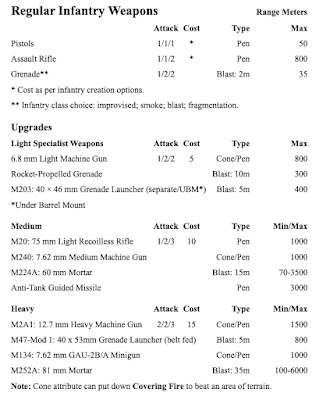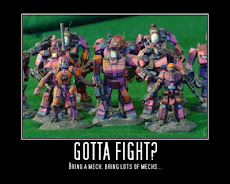One of the problems with writing a set of SF rules is how players create forces. One can create specific army formations, or have players choose from lists, or give them the tools to create any force they want.
The first option is too rigid for my tastes and leads to endless Codex's or whatever. The second I think is great for historical games, but fails for SF because, see option one. And, the third option, which is my favourite, requires more work so ,I've broken it down into chunks to run past you, my readers.
Third World Militaries field infantry with a wide range between the quality of troops and their weapons. They are broken down into two broad categories:
Insurgent Forces
Insurgents are civilians taking up arms against their own governments or occupying forces. Insurgents fall broadly into three categories.
Civilian irregulars are lightly armed troops with personal weapons. They can carry a grenade/improvised explosive device, or field expedient bomb. They can only create smoke by starting a fire with Molotov cocktails.
Civilian fighters are well armed, and carry blast/fragmentation grenades as standard. They too can only create smoke using Molotov cocktails.
Civilian militia are heavily armed infantry. Command level one militia carry blast/fragmentation grenades only. Command level two militia carry blast/fragmentation and smoke grenades as standard.
All civilian militia and army personnel have soft armor jackets, with plates.
Government Armies
Regular government militaries are divided by training.
1. Conscript troops are civilians drafted willingly or unwillingly into the army.
2. Green troops are trained volunteers.
3. Veteran troops are trained competent soldiers.
Army units of varying degrees of competence and or military equipment. With access to resources that may not be available to civilian fighters or militia, depending on the scenario. These infantry are assumed to carry enough grenades on them for one battle.
Teams are the building blocks for a squad. And those squads are the building blocks for a platoon.
When a players' force takes casualties, the results are assigned to the team that has been attacked, according to how it is organized.
Therefore,
squads with two or more teams have the option to spread the results
across them all. And then players add leaders as follows:
And because none of the above has considered support weapons, the stats for the weapons are below, here are the options for them:
Light Specialist Weapon Team Options
1. Upgrade. One member of the team carries a light machine gun, RPG, or grenade launcher, which allows the team to attack at that weapon’s value. A team with a light machine gun, RPG, or grenade launcher, can choose to fire with that weapon or fire with their normal weapons. Base cost 5.
Medium Specialist Weapon Team Options
1. Upgrade. One member of the team carries the ATGM, and reloads are spread amongst the rest of the team. A team with an ATGM can choose to fire the ATGM and fire as normal at a target. Base cost 10.
2a. Medium machine guns are mounted on either a bipod or tripod, this makes the team burdened. Therefore they cannot move and fire in the same turn.
2b. Medium machine gun teams can be mounted on a vehicle at the base cost for the weapon and crew. But then the cost of the vehicle has to be added, and the team counts as a platoon support asset. Platoon assets can sometimes be limited by specific scenario missions.
3. Light 60 mm mortars, once emplaced cannot move and fire. Mortars require a crew of two and they become a separate team when assigned a junior leader. The mortar can be mounted in a vehicle at the additional cost of the vehicle, allowing the mortar team to fire and move, but it then becomes a platoon asset, which may be limited by specific scenario missions.
Heavy Specialist Weapon Team Options
1. Snipers are a platoon asset. They come in teams of two (spotter and shooter) included in the base cost. Platoon assets can sometimes be limited by specific scenario missions. Veteran forces can upgrade a team for 7 points, limited to one per squad.
2. Heavy machine guns are tripod mounted and require a gunner and loader. They are always considered platoon-level assets. A heavy machine gun once emplaced cannot move and fire when deployed as infantry. If mounted on a vehicle, at the cost of the crew and the vehicle, then it can move and fire. But this option may be limited by specific scenario missions.
3a. M252A 81 mm mortars, once emplaced cannot move and fire. Mortars require a crew of two and they become a separate team when assigned a junior leader. The mortar can be mounted in a vehicle at the addition cost of the vehicle, allowing the mortar team to fire and move, but it then becomes a platoon asset, which may be limited by specific scenario missions.
3b. M121A heavy 120 mm mortars require a crew of five (a team with a junior leader). Once emplaced, heavy mortars cannot move and fire. These heavy mortars are classified as a platoon asset, which may be limited by specific scenario missions. The mortar can be mounted in a vehicle at the additional cost of the vehicle, allowing the mortar team to fire and move, but is then classed as a vehicle.
4. Miniguns are always mounted on vehicles because they require a power source to fire. Therefore the cost here is for the weapon, the cost of the vehicle is extra. Miniguns are always attached to platoons, and are subject to specific scenario mission limitations.
Notes: Specialist Weapon Teams
• Specialist weapon crew do not carry grenades.
• Medium and heavy specialist crew only carry additional ammunition and or the tripod for the weapon. They carry a personal pistol for self-defense.
• If the crew of a specialist weapon team are killed, reducing them to less than the minimum number to move and fire. Then the surviving crew may:
⁃ Only fire the weapon if already placed on overwatch during the player’s turn sequence. But they cannot move during the player’s next turn sequence.
⁃ Or they can abandon the weapon, and move and fire their personal weapons as ordinary infantry.
• If available, players can transfer figures from one squad to the team. To do this, requires the player to spend one command initiative point. But the specialist weapon team cannot move until the turn sequence after the replacement crew arrive.
• If all the crew were killed, then the specialist weapon team cannot be moved or fired during the player's next turn sequence
Let me know what you all think?















.png)




